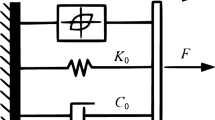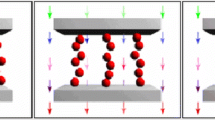Abstract
In this research, the application of active mass damper (AMD) has been experimentally tested using electromagnetic uniaxial shake table. The characteristic of an active damper has been presented. A state-feedback controller has been introduced for single flood active mass damper (AMD) using numerical modeling. The model was built and experiment was performed in laboratory having AMD to discuss the effect of model parameters and the development of parameters by inputting the data obtained from most severe earthquake on Oct 8 2005 in Pakistan. The system model, control design and observer were tested on shake table having 46 cm × 46 cm dimensions in real time vibrations. The shake table used has capability of running with powerful actuator having scaled accelerograms of real time earthquakes. The setup to operate the controller on real experimental work was discussed. It was observed that about 40% reduction in vibration can be achieved using active mass damper.









Similar content being viewed by others
References
Bhatti AQ, Zamir S, Rafi Z, Khatoon Z, Ali Q (2011) Probabilistic seismic hazard analysis of Islamabad. J Asian Earth Sci 42(3):468–478. https://doi.org/10.1016/j.jseaes.2011.05.006
EERI Special Earthquake Report (2006) Learning from earthquakes the kashmir earthquake of october 8, 2005: impacts in Pakistan
Bhatti AQ (2016) Application of dynamic analysis and modelling of structural concrete insulated panels (SCIP) for energy efficient buildings in seismic prone areas. Elsevier J Energy Build 128:164–177. https://doi.org/10.1016/j.enbuild.2016.06.049
Bhatti AQ (2016) Scaled accelerographs for design of structures in Quetta, Baluchistan Pakistan. Int J Adv Struct Eng (IJASE) 8(4):401–410. https://doi.org/10.1007/s40091-016-0141
Bhatti AQ (2017) Dynamic response characteristics of steel portal frames having semi rigid joints under sinusoidal wave excitation. Int J Adv Struct Eng (IJASE) 9(4):309–313. https://doi.org/10.1007/s40091-017-0167-8
Battaini M, Yang G, Spencer BF Jr (2000) Bench-scale experiment for structural control. J Eng Mech ASCE 126(2):140–148
Battaini M, Dyke SJ (1998) Fault tolerant structural control systems for civil engineering applications. J Struct Control 5:1–26. https://doi.org/10.1002/stc.4300050101
Kareem A, Kijewski T (1999) Mitigation of motions of tall buildings with specific examples of recent applications. Wind Struct 2:201–251
Suhardjo J, Spencer BF Jr, Kareem A (1992) Frequency domain optimal control of wind excited buildings. ASCE J Eng Mech 118:2463–2481
Suhardjo J, Kareem A (1997) Structural control of off-shore platforms. In: Proceedings of the 7th international off-shore and polar engineering conference IOSPE-7, Honolulu
Housner G et al (1997) Structural control: past, present and future. ASCE J Eng Mech 123:897–971
Bhatti AQ (2013) Performance of viscoelastic dampers (VED) under various temperatures and application of magnetorheological dampers (MRD) for seismic control of structures. Mech Time Depend Mater (MTDM) 17(3):275–284. https://doi.org/10.1007/s11043-012-9180-2
Linderman LE, Spencer BF Jr (2016) Decentralized active control of multistory civil structure with wireless smart sensor nodes. J Eng Mech. https://doi.org/10.1061/(ASCE)EM.1943-7889.0001126
Bhatti AQ (2005) Effective force testing: a method of seismic simulation for structural testing using electromagnetic structure. Master Thesis Paper Department of Built Environment, Tokyo Institute of Technology Japan, vol 9, pp 181–185
Zhang C, Ou J (2015) Modeling and dynamical performance of the electromagnetic mass driver system for structural vibration control. Eng Struct 82:93–103. https://doi.org/10.1016/j.engstruct.2014.10.029
Durrani AJ, Elnashai AS, Hash-ash YMA, Masud A (2005) The Kashmir Earthquake of October 8, 2005. A Quick Look Report. Mid-America Earthquake Center, University of Illinois at Urbana-Champaign
Varum H, Teixeira-Dias F, Marques P, Pinto A, Bhatti AQ (2014) Performance evaluation of retrofitting strategies for non-seismically designed RC buildings using steel braces. Bull Earthq Eng 11(4):1129–1156. https://doi.org/10.1007/s10518-012-9421-4
Khan IU, Shan DS, Bhatti AQ (2014) Temperature effect analysis of viscoelastic damper and Magnetorheological damper for vibration control of stayed-cable. Bridge Maint Saf Manag Life Ext. https://doi.org/10.1201/b17063-332
Soong TT (1990) Active structural control: theory and practice. Longman Scientific and Technical Essex, England
Whalen TM, Bhatia KM, Archer GC (2002) Semi-active vibration control for the 3rd generation benchmark problem including modal spillover suppression. In: Proceedings of the 15th ASCE engineering mechanics conference. Columbia University, New York
Doyle TC et al (1989) State space solutions to standard H2 and H∞ control problems. IEEE Trans Autom Control 34(8):831–847
Duke SJ et al (1996) Acceleration feedback control of MDOF systems. ASCE J Eng Mech 122:907–917
Gaviria CA, Montejo LA (2016) Output-only identification of the modal and physical properties of structures using free vibration response. Earthq Eng Eng Vib 15(3):575–589. https://doi.org/10.1007/s11803-016-0345-x
Pujol G, Acho L (2013) Active control for a perturbed flexible structure: an experimental study. Asian J Control 15:1566–1570. https://doi.org/10.1002/asjc.582
Agranovich G, Ribakov Y (2013) Scaling ground motions using optimal feedback control for testing structures by shake table. Struct Control Health Monit 20:1176–1190. https://doi.org/10.1002/stc.1526
Author information
Authors and Affiliations
Corresponding author
Rights and permissions
About this article
Cite this article
Bhatti, A.Q. Structural health monitoring of single degree of freedom flexible structure having active mass damper under seismic load. Innov. Infrastruct. Solut. 3, 33 (2018). https://doi.org/10.1007/s41062-018-0139-2
Received:
Accepted:
Published:
DOI: https://doi.org/10.1007/s41062-018-0139-2




